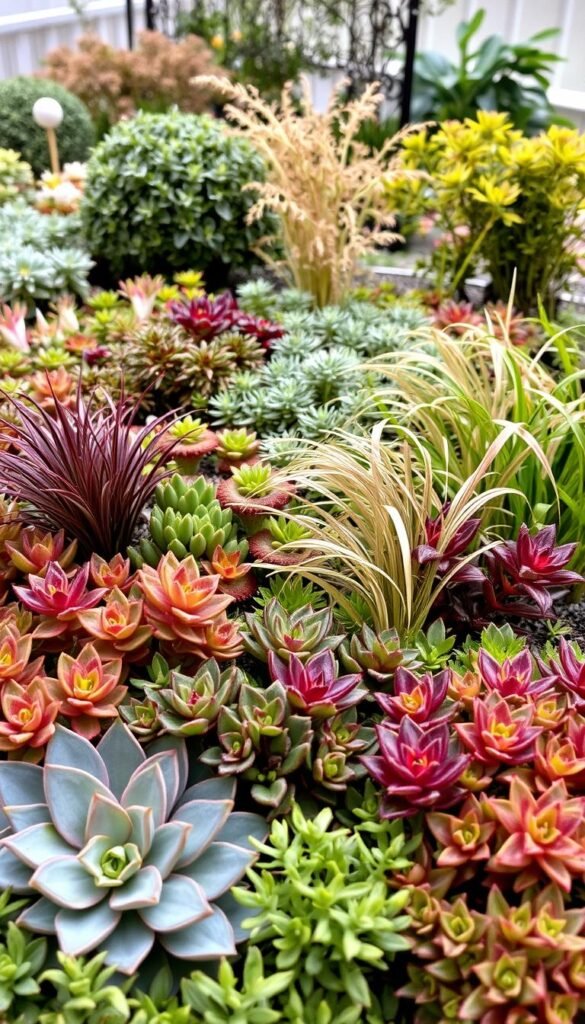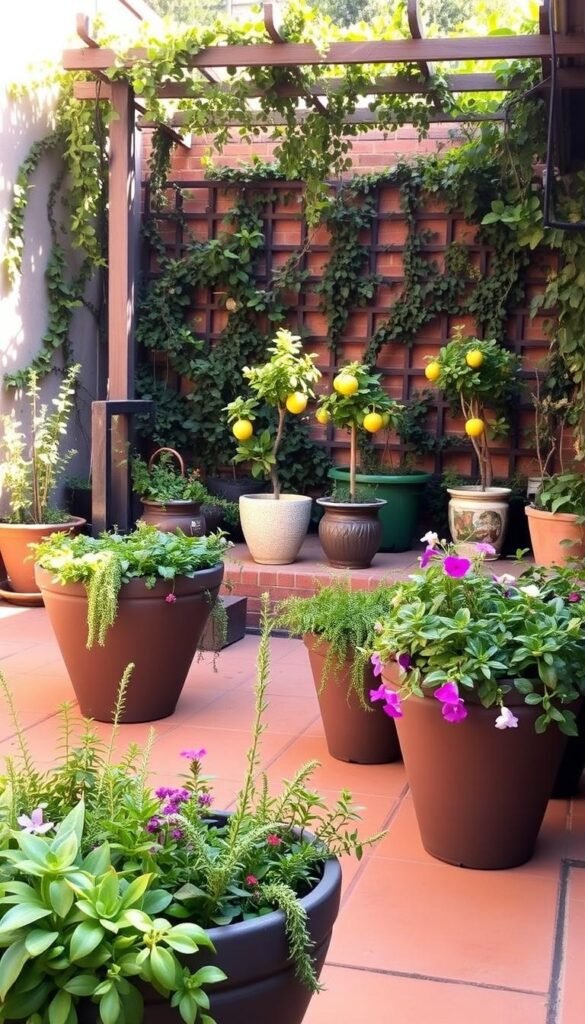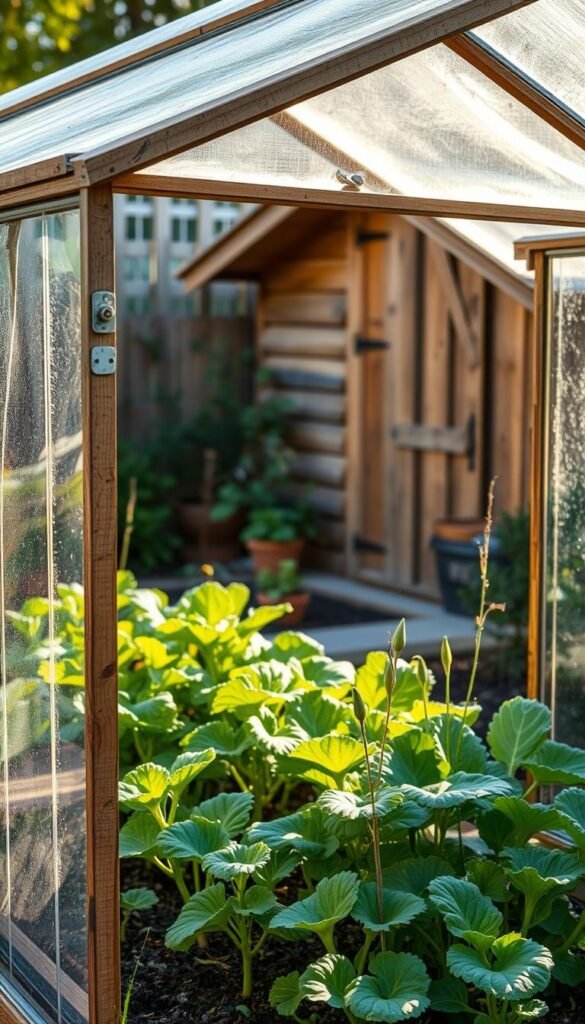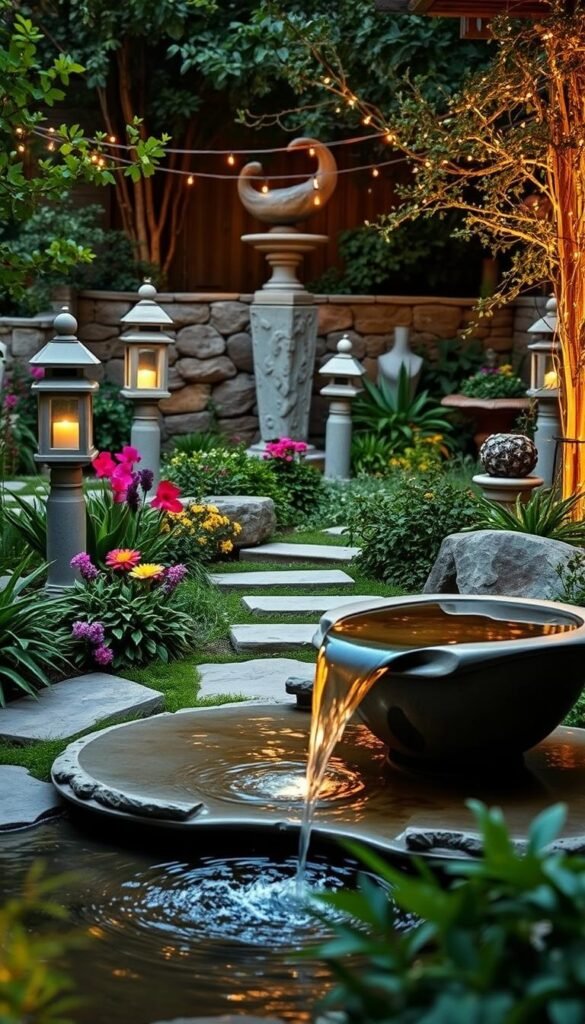Even with minimal room, you can create a thriving garden full of fresh produce and vibrant blooms. More people are embracing compact gardening to grow their own food and enjoy nature. With smart techniques, every inch counts.
Vertical planters, raised beds, and dwarf plants help maximize yield without overcrowding. Proper planning ensures your space works efficiently. Track sunlight, improve soil, and arrange layouts for success.
Seasoned gardeners with 15 years of experience prove tiny plots can flourish. Whether you want herbs, veggies, or flowers, creative solutions turn limitations into opportunities. Start small, think smart, and watch your green haven thrive.
Assess Your Space and Sunlight
Limited square footage doesn’t mean you can’t cultivate a lush oasis. Start by evaluating your area’s layout and light exposure. These factors determine which plants grow best and where.
Measure Your Area’s Dimensions
Grab a tape measure and map boundaries. Note obstacles like fences or walkways. Even tiny nooks can host herbs or compact veggies.
- Mark sunny vs. shaded zones with chalk.
- Leave pathways for easy access.
- Match plant size to available space garden areas.
Track Sunlight Patterns
Most vegetable garden favorites need 6–8 hours of direct sunlight. Observe patterns over a day:
- South-facing spots suit tomatoes and peppers.
- Move containers to “chase” light as seasons shift.
- Windowsills work for microgreens in winter.
With data in hand, arrange plants strategically. Your garden will thrive when every ray counts.
Start with Raised Beds for Better Soil Control

Raised beds unlock precision control over your growing environment. They let you tailor soil conditions, boost drainage, and avoid compaction—key for healthy roots.
Why Modular Raised Beds Shine
Prefabricated metal or wood raised beds adapt to odd corners. Their slim profiles fit patios, balconies, or narrow strips. Benefits include:
- Improved soil structure with fewer weeds.
- Warmer ground in spring for earlier planting.
- Easy access (keep width under 4 feet).
DIY Ideas for Thrifty Gardeners
Upcycle materials for budget-friendly beds:
- Cinder blocks lined with landscape fabric.
- Old drawers or wine barrels with drilled holes.
- Reclaimed wood frames layered with compost.
Top beds with mulch to retain moisture. Add trellises on the north side to avoid shading low-growing garden favorites like lettuce or radishes.
Embrace Vertical Gardening
When ground space is limited, look up—vertical gardening opens new possibilities. Walls, fences, and balconies become prime real estate for plants. This method boosts yield without sacrificing walkways or sun exposure.
Trellises for Climbing Plants
Sturdy supports let cucumbers, beans, and pumpkins reach for the sky. Cattle panel trellises handle heavy vines, while bamboo poles suit lightweight climbers like peas.
| Trellis Type | Best For | Pros |
|---|---|---|
| Cattle Panels | Cucumbers, melons | Durable, wide spacing |
| A-Frame Wood | Pole beans, peas | Easy harvest access |
| Espalier Wire | Fruit trees | Space-saving, decorative |
“Vertical structures turn wasted airspace into a harvest zone.”
Hanging Planters and Living Walls
GreenStalk tiered planters stack strawberries or herbs in layers. Wall-mounted pockets host thyme or mint, while hanging baskets spill cherry tomatoes downward. Position these on north-facing surfaces to avoid shading sun-loving garden beds.
- Use morning glories for colorful shade on pergolas.
- Install hooks for adjustable height as plants grow.
- Combine edible and ornamental vines for dual-purpose beauty.
Choose Compact and Dwarf Plant Varieties

Dwarf varieties transform tight spots into productive zones. These plants deliver full-sized flavor in petite packages, making them perfect for a compact garden. Focus on high-yield options that thrive in confined space.
Top Vegetables for Limited Areas
Bush-type vegetable cultivars stay tidy while producing heavily. Try ‘Patio Princess’ tomatoes or ‘Spacemaster’ cucumbers in 24-inch containers. Dwarf corn and ‘Little Gem’ lettuce offer quick harvests without sprawl.
- Pair compact basil with taller crops for layered growth.
- Avoid invasive mint—opt for contained thyme instead.
- Determinate tomatoes stop growing at 3–4 feet.
Petite Fruit Trees and Herbs
Dwarf fruit trees like Meyer lemon thrive in pots. Blueberries such as ‘Top Hat’ yield pints of berries on 2-foot bushes. Herbs like rosemary and oregano add flavor without hogging room.
“Miniature varieties let you grow orchards on patios.”
Stagger plant heights to maximize sunlight. Place trailing strawberries in hanging baskets above dwarf kale. Every inch counts when designing a lush, efficient small space oasis.
Optimize Layout with Square-Foot Gardening
Square-foot gardening transforms tiny plots into high-yield spaces. This method packs plants efficiently using a grid system, ideal for raised beds or compact ground plots. You’ll harvest more while reducing weeds and water waste.
Divide Your Garden into Squares
Mark a 4×4-foot space into 16 equal squares using lattice or waterproof markers. Each square hosts a different crop based on size. For example:
- 1 cauliflower or 16 radishes per square.
- 9 turnips or 4 lettuce heads per square.
Tall crops like corn go north to avoid shading shorter plants. Pair them with spinach or strawberries for layered growth.
Plant Spacing Guidelines
Follow Mel Bartholomew’s spacing rules to prevent overcrowding. Here’s a quick reference:
| Plant | Per Square | Notes |
|---|---|---|
| Tomatoes | 1 | Use cages |
| Carrots | 16 | Thin to 2″ apart |
| Bush Beans | 9 | Harvest in 50 days |
“Square-foot gardening lets you grow a vegetable garden in 20% of the space with 80% less work.”
Rotate crops yearly to keep soil healthy. Add marigolds to deter pests naturally. With this system, even a 4-foot bed feeds a family all season.
Small Backyard? Here’s How to Maximize Your Garden’s Potential with Containers

Containers offer endless flexibility for growing in tight quarters. Whether you have a balcony, patio, or just a sunny windowsill, pots let you cultivate fresh herbs, veggies, and flowers. They’re ideal for renters or those with poor soil.
Pick the Perfect Planters
Choose materials based on your needs. Lightweight resin pots are easy to move, while 5-gallon buckets with drilled holes suit peppers and tomatoes. Fabric containers like GrowBags prevent root rot and improve air flow.
Self-watering planters keep herbs consistently moist—perfect for basil or parsley. For strawberries, try stacked pots that grow vertically. Bonus tip: Line metal containers with burlap to insulate roots on hot days.
Create a Mobile Garden
Containers let you chase sunlight. Rotate them weekly so plants grow evenly. Use wheeled saucers for heavy pots, or hang baskets from adjustable hooks.
“A rolling cart with casters turns any spot into a sun-soaked microgarden.”
Edible flowers like pansies brighten railing planters. Pair them with trailing nasturtiums for color and pest control. With smart placement, even a fire escape can yield a harvest.
Use Succession Planting for Continuous Harvests
Keep your garden productive all year by rotating crops strategically. Succession planting ensures fresh yields from the same space, maximizing every inch of your growing season. With smart timing, you’ll enjoy non-stop harvests without overcrowding.
Stagger Planting Dates
Spread out sowing to avoid gluts and gaps. Plant bush beans every two weeks for a steady supply. Quick-growing radishes mature in 30 days, freeing up room for slower plants like carrots.
- Replace spring peas with summer beans after harvest.
- Follow early tomatoes with fall kale or spinach.
- Use fast-maturing arugula as a placeholder for Brussels sprouts.
Cool-Weather vs. Warm-Weather Crops
Alternate crops based on temperature tolerance. Lettuce thrives in spring and fall, while peppers need summer heat. After squash vines succumb to borers, replant with cool-season broccoli.
“A well-planned schedule turns one bed into three seasonal harvests.”
- Start frost-tolerant peas as soon as soil thaws.
- Protect young lettuce with cloches in early spring.
- Consult local frost dates to time plantings perfectly.
Track planting times in a journal for future reference. Layer compost between rotations to replenish nutrients. With succession planting, your garden becomes a year-round pantry.
Try Companion Planting for Space Efficiency
Smart plant partnerships can double your garden’s productivity. By grouping species that support each other, you’ll save space, deter pests, and improve soil health. It’s like creating a mini ecosystem where every plant plays a role.
Classic Pairings That Work
The Three Sisters method—corn, beans, and squash—is a timeless example. Corn stalks support climbing beans, while squash leaves shade the soil, reducing weeds. This trio maximizes vertical growth and nutrient sharing.
Natural Pest Control Combos
Some plants repel pests or attract beneficial insects. Basil near tomatoes wards off aphids and enhances flavor. Marigolds in vegetable garden beds deter nematodes, while nasturtiums lure cabbage moths away from brassicas.
- Carrots + onions: Confuse root pests with their contrasting scents.
- Garlic + roses: Deters aphids and adds a fragrant border.
- Avoid planting potatoes near tomatoes—both attract blight.
“Companion planting is nature’s cheat code for healthier crops.”
Rotate pairs yearly to prevent soil depletion. With thoughtful planning, your compact plot can yield like a farm.
Incorporate Edible Flowers and Pollinators
Brighten your compact space with blooms that pull double duty. Edible varieties like nasturtiums and calendula add vibrant color to salads while attracting bees. These multitaskers make every inch work harder.
Top Picks for Tiny Plots
Choose flowers that fit tight spaces and serve a purpose. Borage blooms garnish drinks and deter tomato hornworms. Chive flowers attract pollinators while adding oniony zest to dishes.
| Flower | Edible Use | Pollinator Benefit |
|---|---|---|
| Nasturtiums | Peppery salad topper | Lures aphids away from veggies |
| Lavender | Herbal teas | Repels deer; attracts bees |
| Zinnias | Petals in desserts | Butterfly magnet |
Invite Bees and Butterflies
Pollinators boost yields in your vegetable garden. Plant dill and arugula—their blooms feed beneficial insects. Avoid pesticides; opt for companion planting instead.
- Set out a shallow dish with rocks for water.
- Group same-color flowers to help pollinators spot them.
- Leave some herbs unharvested to flower.
“A garden buzzing with life is a garden bursting with harvests.”
Mix edible and ornamental varieties for beauty and function. Your plants thrive when pollinators visit often. Even a tiny plot can support ecosystems and your kitchen.
Extend the Season with Simple Techniques

Stretch your harvests beyond summer with clever season-extending tricks. A little planning and the right tools keep your garden productive even as temperatures drop. From frost shields to indoor nurseries, these methods buy precious time.
Cold Frames and Cloches: Frost Fighters
Protect tender plants with mini greenhouses. Cold frames—angled boxes with clear lids—trap heat and shield spinach or kale into winter. For a thrifty option, repurpose old windows and straw bales into a DIY frame.
- Milk jug cloches: Cut the bottom off and place over seedlings to block frost.
- Row covers: Lightweight fabric keeps leafy greens growing weeks longer.
- Thermal mass: Add dark stones or water jugs to absorb daytime heat.
| Tool | Best For | Cost |
|---|---|---|
| Cold Frame | Leafy greens, root veggies | $50–$150 |
| Hoop House | Tomatoes, peppers | $20 (PVC DIY) |
| Cloche | Seedlings, herbs | Free (upcycled) |
Indoor Seed Starting: Get a Head Start
Begin your growing season early by nurturing sprouts indoors. Broccoli and cabbage seeds thrive under grow lights, ready for transplanting when soil warms. Use egg cartons or yogurt cups with drainage holes for budget-friendly pots.
“A sunny windowsill can become a nursery for fall crops like kale and Brussels sprouts.”
Pair these techniques with sustainable raised bed techniques for a non-stop harvest. With a bit of care, you’ll enjoy fresh flavors long after summer fades.
Improve Soil Health in Confined Spaces
Healthy soil is the foundation of a thriving garden, even in tight areas. Nutrient-rich earth boosts growth and prevents disease. With smart techniques, you can transform limited plots into fertile ground.
Turn Kitchen Scraps into Black Gold
Composting recycles waste into rich organic matter. A tumbler system keeps odors contained while speeding up decomposition. Add equal parts greens (veggie scraps) and browns (dry leaves) for balanced compost.
- Use OMRI-certified compost for organic safety.
- Bury food scraps directly in raised beds for no-mess enrichment.
- Worm bins create nutrient-dense castings for containers.
Green Manures for Tiny Plots
Cover crops like clover or vetch nourish beds between plantings. The “chop-and-drop” method cuts plants at soil level, leaving roots to decompose. Benefits include:
- Nitrogen fixation for heavy feeders like tomatoes.
- Weed suppression without chemicals.
- Improved water retention in sandy soils.
“Feed the soil, and the soil will feed your plants.”
Test pH yearly with a simple kit. Most veggies prefer 6.0–7.0. Add lime to sweeten acidic earth or sulfur to lower alkalinity. Avoid synthetic fertilizers—they harm beneficial microbes.
| Amendment | Purpose | Application Rate |
|---|---|---|
| Compost | General fertility | 2–3 inches yearly |
| Worm Castings | Root development | 1 cup per plant |
| Clover Seed | Nitrogen boost | 1 oz per 10 sq ft |
Layer mulch to protect earthworms and retain moisture. With these methods, your compact space will yield like a farm.
Add Decorative and Functional Elements

Your garden can be both beautiful and practical with the right touches. Thoughtful additions enhance aesthetics while solving common challenges. From lighting to art, these elements make your space more enjoyable.
Illuminate with Purpose
Solar lanterns extend evening use without wiring. String lights over seating areas create ambiance while marking pathways. Consider these lighting options:
- LED stake lights: Highlight plants and borders safely.
- Motion-activated spots: Deter pests while lighting walkways.
- Hanging mason jars: DIY charm with tea lights or solar bulbs.
Water Features That Work Hard
A recirculating fountain masks urban noise while attracting birds. Small ponds with floating plants like water lettuce add tranquility. Benefits include:
- Humidity for ferns and tropical varieties.
- Drinking source for pollinators and pest-eating birds.
- Natural white noise for relaxation.
“A bubbling fountain turns a corner into a calming retreat.”
Art with Multiple Roles
Choose pieces that serve your garden beyond decoration. Painted trellises support climbers while adding color. Repurposed items bring character:
| Element | Function | Style Tip |
|---|---|---|
| Old ladders | Vertical plant stands | Paint in bold hues |
| Metal sculptures | Stake supports | Choose rust-resistant |
| Mosaic stepping stones | Path markers | Use broken pottery |
Bird feeders double as living art while controlling pests. Select designs that complement your theme—rustic cedar for cottage gardens or sleek metal for modern spaces.
Care Through Design
Every addition should simplify maintenance. Rain chains direct water to barrels while adding visual interest. Decorative mulch covers reduce weeding while retaining moisture.
- Use colored glass globes as plant markers.
- Install a vintage thermometer near heat-loving crops.
- Paint container numbers to track planting dates.
With these elements, your garden becomes an extension of your living space. Function meets beauty in every detail.
Explore Community Gardens or Shared Spaces
Don’t let limited room stop you from growing fresh food. Community plots offer extra space to cultivate your favorite plants. These shared resources connect gardeners while boosting local food production.
Finding Local Plots Near You
Many cities provide affordable garden rentals through parks departments. Libraries often host adjacent plots, blending education with hands-on growth. Start your search with these steps:
- Check municipal websites for managed gardens
- Visit farmers’ markets—vendors often know available spaces
- Join neighborhood Facebook groups to discover private land shares
Some programs offer reduced fees for growing vegetable donations. Others provide free compost and tools. Always review plot rules before signing up.
Building Connections Through Collaboration
Shared spaces thrive on teamwork. Trade extra zucchini for a neighbor’s heirloom tomatoes. Organize monthly crop swaps to diversify harvests. Consider these cooperative ideas:
| Activity | Benefits |
|---|---|
| Tool lending | Saves money on tillers and wheelbarrows |
| Seed-starting workshops | Shares knowledge while building friendships |
| Group composting | Creates rich soil for all participants |
“A community garden turns strangers into teammates with dirt under their nails.”
Document your journey in a shared journal. Note planting dates, pest solutions, and bumper crops. These records help future gardeners succeed in the same space.
Your Lush, Productive Garden Awaits
Turn constraints into creativity with a flourishing garden in any area. Vertical planters, nutrient-rich raised beds, and strategic layouts unlock abundance. Start small—one container or plot can yield herbs, tomatoes, or blooms.
Adapt techniques to your space. Trellises save ground room, while succession planting keeps harvests rolling. Healthy plants begin with compost and sunlight. Celebrate plucking sun-warmed strawberries or snipping basil for dinner.
The joy of gardening grows with every season. Whether you nurture a patio pot or a vegetable garden, each effort adds flavor and beauty. Grab your gloves and dig in—your green haven starts today!






